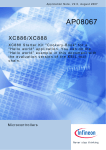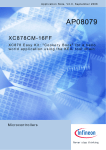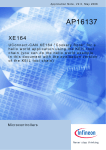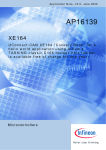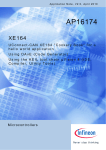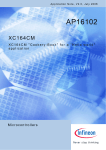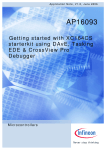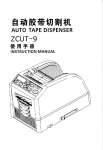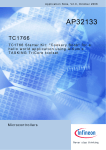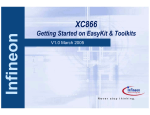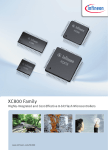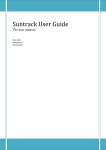Download AP08073 - Infineon
Transcript
Application Note, V2.0, May 2008 AP08073 XC888 XC800 USCALE start kit: "Cookery Book" for a hello world application using the KEIL tool chain Microcontrollers Edition 2008-07-16 Published by Infineon Technologies AG 81726 München, Germany © Infineon Technologies AG 2008. All Rights Reserved. LEGAL DISCLAIMER THE INFORMATION GIVEN IN THIS APPLICATION NOTE IS GIVEN AS A HINT FOR THE IMPLEMENTATION OF THE INFINEON TECHNOLOGIES COMPONENT ONLY AND SHALL NOT BE REGARDED AS ANY DESCRIPTION OR WARRANTY OF A CERTAIN FUNCTIONALITY, CONDITION OR QUALITY OF THE INFINEON TECHNOLOGIES COMPONENT. THE RECIPIENT OF THIS APPLICATION NOTE MUST VERIFY ANY FUNCTION DESCRIBED HEREIN IN THE REAL APPLICATION. INFINEON TECHNOLOGIES HEREBY DISCLAIMS ANY AND ALL WARRANTIES AND LIABILITIES OF ANY KIND (INCLUDING WITHOUT LIMITATION WARRANTIES OF NON-INFRINGEMENT OF INTELLECTUAL PROPERTY RIGHTS OF ANY THIRD PARTY) WITH RESPECT TO ANY AND ALL INFORMATION GIVEN IN THIS APPLICATION NOTE. Information For further information on technology, delivery terms and conditions and prices please contact your nearest Infineon Technologies Office (www.infineon.com). Warnings Due to technical requirements components may contain dangerous substances. For information on the types in question please contact your nearest Infineon Technologies Office. Infineon Technologies Components may only be used in life-support devices or systems with the express written approval of Infineon Technologies, if a failure of such components can reasonably be expected to cause the failure of that life-support device or system, or to affect the safety or effectiveness of that device or system. Life support devices or systems are intended to be implanted in the human body, or to support and/or maintain and sustain and/or protect human life. If they fail, it is reasonable to assume that the health of the user or other persons may be endangered. AP08073 XC800 USCALE start kit: "Cookery Book" AP08048 Revision History: Previous Version: Page 2008-05 none Subjects (major changes since last revision) V2.0 We Listen to Your Comments Any information within this document that you feel is wrong, unclear or missing at all? Your feedback will help us to continuously improve the quality of this document. Please send your proposal (including a reference to this document) to: [email protected] Application Note 3 V2.0, 2008-05 AP08073 XC800 USCALE start kit: "Cookery Book" Table of Contents Page Note: Table of Contents see page 9. Introduction: This “Appnote” is a Hands-On-Training / Cookery Book / step-by-step book. It will help inexperienced users to get the XC800-USCALE-start-kit up and running. With this step-by-step book you should be able to get your first useful program in less than 2 hours. The purpose of this document is to gain know-how of the microcontroller and the tool-chain. Additionally, the "hello-world-example" can easily be expanded to suit your needs. You can connect either a part of - or your entire application to the XC800-USCALE-start-kit. You are also able to benchmark any of your algorithms to find out if the selected microcontroller fulfils all the required functions within the time frame needed. Note: The style used in this document focuses on working through this material as fast and easily as possible. That means there are full screenshots instead of dialog-window-screenshots; extensive use of colours and page breaks; and listed source-code is not formatted to ease copy & paste. Have fun and enjoy the XC800-USCALE-start-kit! Application Note 4 V2.0, 2008-05 AP08073 XC800 USCALE start kit: "Cookery Book" Application Note 5 V2.0, 2008-05 AP08073 XC800 USCALE start kit: "Cookery Book" Note: The XC800 USCALE START KIT includes 3 XC800 (XC866, XC886, XC888) microcontrollers. Only one microcontroller can be active at any given time. The other 2 will remain in reset. Therefore the debugger must be permanently connected to the XC800 USCALE START KIT during operation to select the active microcontroller. The active microcontroller will be indicated by one of the 3 yellow LEDs. In this document we are going to use the XC888 microcontroller. Port_1_Pin_5 (User LED red) XC866 XC886 Application Note 6 XC888: when the XC888 is selected by the debugger the LED is lit. Run (LED green) V2.0, 2008-05 AP08073 XC800 USCALE start kit: "Cookery Book" Used/selected microcontroller: SAF XC888CM-8FFI Block Diagram (Source: Product Marketing) XC888CM Block Diagram (Source: DAvE) Application Note 7 V2.0, 2008-05 AP08073 XC800 USCALE start kit: "Cookery Book" XC888CM Block Diagram (Source: User’s Manual) XC888CM functional units (Source: User’s Manual) Note: Just by comparing the different sources of block diagrams, you should be able to get a complete picture of the product and to answer some of your initial questions. Application Note 8 V2.0, 2008-05 AP08073 XC800 USCALE start kit: "Cookery Book" “Cookery-book“ For your first programming example for the XC800 USCALE start kit: Your program: Chapter/ Step *** Recipes *** 1.) DAS Installation + Connecting the XC800 USCALE start kit 2.) DAvE (program generator) DAvE Installation (mothersystem) + DAvE Update Installation (XC888.DIP) for XC888 3.) Using DAvE Microcontroller initialization for your programming example 4.) Using the KEIL Development Tools (C-Compiler) Programming of your application (XC888) with the KEIL tool chain (µVision3) Compiler V8.12c + first steps with the Simulator 5.) Using the simulator 6.) Using real hardware (+ OnChipFlash-Programming) Feedback 7.) Feedback Application Note 9 V2.0, 2008-05 AP08073 XC800 USCALE start kit: "Cookery Book" 1.) DAS Installation + Connecting the XC800 USCALE start kit: Application Note 10 V2.0, 2008-05 AP08073 XC800 USCALE start kit: "Cookery Book" Screenshot of the XC800 USCALE start kit homepage: http://www.infineon.com/cms/en/product/channel.html?channel=db3a304312fcb1bc01130bbf1ed50 9c3&navigation=menu Application Note 11 V2.0, 2008-05 AP08073 XC800 USCALE start kit: "Cookery Book" Note: For further information, please refer to the USCALE-XC800 System Description . Application Note 12 V2.0, 2008-05 AP08073 XC800 USCALE start kit: "Cookery Book" Install the Infineon DAS (D e v i c e A c c e s s S e r v e r) Server: Go to www.infineon.com/DAS: Note: The DAS Server must be installed on your host computer! The goal of the DAS software is to provide one single interface for all types of tools. The USB Device driver communicates with the XC800 USCALE start kit when connected to the host computer. The USB Device driver for the XC800 USCALE start kit USB interface is included in the DAS software. A virtual COM port driver is also included. Application Note 13 V2.0, 2008-05 AP08073 XC800 USCALE start kit: "Cookery Book" Download “The latest release version for download: DAS Edition v2.6.4”: Unzip das_edition_v264.zip and Application Note 14 V2.0, 2008-05 AP08073 XC800 USCALE start kit: "Cookery Book" execute “DAS_v264_setup.exe” to install the DAS Server. Application Note 15 V2.0, 2008-05 AP08073 XC800 USCALE start kit: "Cookery Book" Click Finish Application Note 16 V2.0, 2008-05 AP08073 XC800 USCALE start kit: "Cookery Book" Connect the XC800 USCALE start kit to the host computer: USB Connection: .) used for: UART communication (the UART/RS232/serial interface is available via USB as a virtual COM port of the second USB channel of the FTDI FT2232 Dual USB to UART/JTAG interface). .) used for: On-Chip-Flash-Programming and Debugging (first USB channel of the FTDI FT2232 Dual USB to UART/JTAG interface). .) the USB connection works also as the power supply. Note: A USB driver is installed the first time while connecting the XC800 USCALE start kit via USB to your host computer. Note: A default virtual COM Port is generated. Application Note 17 V2.0, 2008-05 AP08073 XC800 USCALE start kit: "Cookery Book" Using a Windows 2000 operating system, we are now going to search for the virtual COM Port which was generated after connecting our XC800 USCALE start kit: Start – Settings – Control Panel Application Note 18 V2.0, 2008-05 AP08073 XC800 USCALE start kit: "Cookery Book" Double click: Administrative Tools Application Note 19 V2.0, 2008-05 AP08073 XC800 USCALE start kit: "Cookery Book" Double click: Computer Management Application Note 20 V2.0, 2008-05 AP08073 XC800 USCALE start kit: "Cookery Book" Click: Device Manager Application Note 21 V2.0, 2008-05 AP08073 XC800 USCALE start kit: "Cookery Book" Expand: Ports (COM & LPT): Expand: Universal Serial Bus controllers: COM5 Note: As we can see: our virtual COM Port for UART/RS232 communication with the XC800 USCALE start kit via USB is COM5! Application Note 22 V2.0, 2008-05 AP08073 XC800 USCALE start kit: "Cookery Book" 2.) DAvE – Installation for XC888 microcontrollers: Install DAvE (mothersystem): Download the DAvE-mothersystem setup.exe @ http://www.infineon.com/DAvE and execute setup.exe to install DAvE . Note: Abort the installation of Acrobat Reader. Application Note 23 V2.0, 2008-05 AP08073 XC800 USCALE start kit: "Cookery Book" Install the XC888 microcontroller support/update (XC888CLM DIP file): 1.) Download the DAvE-update-file (.DIP) for the required microcontroller @ http://www.infineon.com/DAvE Unzip the zip-file “XC888CLM_v1[1].4.zip” and save “ XC888CLM.DIP “ @ e.g. D:\DAvE\XC888-2008-05-26\XC888CLM.dip. Application Note 24 V2.0, 2008-05 AP08073 XC800 USCALE start kit: "Cookery Book" 2.) Start DAvE - ( click ) 3.) View Setup Wizard Default: • Installation Forward> Select: • I want to install products from the DAvE’s web site Forward> Select: D:\DAvE\XC888-2008-05-26 Forward> Select: Available Products click D XC888CLM Forward> Install End 4.) DAvE is now ready to generate code for the XC888CLM microcontroller. Application Note 25 V2.0, 2008-05 AP08073 XC800 USCALE start kit: "Cookery Book" 3.) DAvE - Microcontroller Initialization after Power-On: Start the program generator DAvE and select the XC888CLM microcontroller: File New 8-Bit Microcontrollers select XC888CLM Create Application Note 26 V2.0, 2008-05 AP08073 XC800 USCALE start kit: "Cookery Book" Choose the Project Settings as you can see in the following screenshots: General: Controller Details: Device: check/select XC888CLM-8FF General: For the KEIL Compiler check/choose ~ Keil in the Compiler Settings: Application Note 27 V2.0, 2008-05 AP08073 XC800 USCALE start kit: "Cookery Book" System Clock: (do nothing) Note: CPU clock is 24 MHz. Application Note 28 V2.0, 2008-05 AP08073 XC800 USCALE start kit: "Cookery Book" Additional information: Clock System (Source: User’s Manual): Clock Generation Unit (CGU) Block Diagram 1 9,6 MHz 2 96 MHz 20 Note: fSYS = fOSC * N / ( P * K ) = 9,6 MHz * 20 / ( 1 * 2 ) = 96 MHz Application Note 29 V2.0, 2008-05 AP08073 XC800 USCALE start kit: "Cookery Book" Additional information: Clock System (Source: User’s Manual): Clock Generation from fsys: 48 24 fSYS/4 48 24 9,6 96 48 24 24 24 48 Note: fSYS = 96 MHz CPU clock: CCLK, SCLK = 24 MHz Fast clock: FCLK = 24 or 48 MHz Peripheral clock: PCLK = 24 MHz Flash Interface clock: CCLK2 = 48 MHz and CCLK = 24 MHz CLKREL: The clock division factor fSYS/4 (see DAvE screenshot page 28) is inclusive the fixed divider factor of 2. Application Note 30 V2.0, 2008-05 AP08073 XC800 USCALE start kit: "Cookery Book" Global Settings: (do not change configuration) * *U Note (Source: DAvE): // You have two choices for Interrupt Service Routine Type Select. // If you select CHOICE 1 then ISR will be generated with push and pop. // If you select CHOICE 2 then ISR will be generated without push and pop. // Default choice is CHOICE 2. // Current selection is CHOICE 2 Note: * = Interrupt Structure 2 applies to Timer 2, Timer 21, UART1, LIN, external interrupts 2 to 6, ADC, SSC, CCU6, Flash, MDU, CORDIC and MultiCAN interrupt sources. There is a slightly different behavior between MODE=0 and MODE=1 in setting/clearing the pending interrupt request bit. *U = If an interrupt node is shared with another interrupt node, the ISR code will be generated in the SHARED_INT.C file. Application Note 31 V2.0, 2008-05 AP08073 XC800 USCALE start kit: "Cookery Book" Notes: If you wish, you can insert your comments here. Exit and Save this dialog now by clicking Application Note the close button: 32 V2.0, 2008-05 AP08073 XC800 USCALE start kit: "Cookery Book" Configuration of the UART: The configuration window/dialog can be opened by clicking the specific block/module. Application Note 33 V2.0, 2008-05 AP08073 XC800 USCALE start kit: "Cookery Book" UART: Transmitter: click ~ Use pin P1.1 (TXD_0) UART: Receiver: click ~ Use pin P1.0 (RXD_0) UART: Receiver Enable: click 9 Enable receiver (REN) UART: Mode Control: click ~ Mode 1: 8-bit shift UART, variable baud rate (see BRG or Timer1) Note: The RS232 serial interface (UART pins P1.0 and P1.1) is available via the USB port as virtual COM port (e.g. COM5) which converts the TTL-UART-signals to USB-signals. Application Note 34 V2.0, 2008-05 AP08073 XC800 USCALE start kit: "Cookery Book" BRG: BRG Run Control: click/check 9 Enable BRG BRG: Fractional Divider Control: click/check 9 Enable Fractional Divider BRG: BRG Settings: Required baud rate [kbaud] insert 9,600 <ENTER> Note: Validate each alphanumeric entry by pressing ENTER. Application Note 35 V2.0, 2008-05 AP08073 XC800 USCALE start kit: "Cookery Book" Interrupts: (do nothing) Priority Note: For the serial communication with a terminal program running on your host computer the printf function is used. The printf function uses Software-Polling-Mode therefore we do not need to configure any interrupts. Application Note 36 V2.0, 2008-05 AP08073 XC800 USCALE start kit: "Cookery Book" Interrupt Priorities: Note (Source: Application Note AP08053): There could be six interrupt priorities. These priorities, with 6 beeing the highest, are as follows: Interrupt Priority: 6 5 4 3 2 1 NMI Interrupt Priority 3 Interrupt Priority 2 Interrupt Priority 1 Interrupt Priority 0 Main Main refers to routines that run prior to any interrupt and can be interrupted by any interrupt. Each interrupt source can be programmed to any of the four interrupt priorities (0-3). An interrupt that is currently being serviced can only be interrupted by a higher-priority interrupt, but not by another interrupt of the same or lower priority. Hence, an interrupt of the highest priority cannot be interrupted by any other interrupt request. In any case, the NMI always has the highest priority (above level 3) and its priority cannot be programmed. Application Note 37 V2.0, 2008-05 AP08073 XC800 USCALE start kit: "Cookery Book" Functions: Initialization Function: click 9 UART_vInit Note: You can change function names (e.g. UART_vInit) and file names (e.g. UART.C) anytime. Application Note 38 V2.0, 2008-05 AP08073 XC800 USCALE start kit: "Cookery Book" Parameters: (do nothing) Notes: If you wish, you can insert your comments here. Exit and Save this dialog now by clicking Application Note the close button. 39 V2.0, 2008-05 AP08073 XC800 USCALE start kit: "Cookery Book" Configure Timer T0: The configuration window/dialog can be opened by clicking the specific block/module. Note: The LED on Port_1_Pin_5 will be blinking (if selected in the main menu) with a frequency of about 1 second (done in the Timer_0-Interrupt-Service-Routine). Therefore we have to configure Timer_0. Application Note 40 V2.0, 2008-05 AP08073 XC800 USCALE start kit: "Cookery Book" Timer0: Timer Mode: click ~ Mode 1: 16-bit timer Timer0: Timer Options: click 9 Turn on timer (TR0) Timer0: Interrupt Control: click 9 Enable interrupt of timer (ET0) Note: We need 183 Timer_0 overflows to achieve an approximate 1 second delay. This will be handled in the Timer_0 interrupt function. 183 * 5461,333 µs = 0,9994 s. Application Note 41 V2.0, 2008-05 AP08073 XC800 USCALE start kit: "Cookery Book" Timer1: do nothing (not used) Application Note 42 V2.0, 2008-05 AP08073 XC800 USCALE start kit: "Cookery Book" Interrupts: (do nothing) Priority Interrupt of Timer_0 is enabled, ET0 = 1 Note (Source: User’s Manual): An interrupt that is currently being serviced can only be interrupted by a higher-priority interrupt, but not by another interrupt of the same or lower priority. Hence, an interrupt of the highest priority cannot be interrupted by any other interrupt request. If two or more requests of different priority levels are received simultaneously, the request with the highest priority is serviced first. If requests of the same priority are received simultaneously, an internal polling sequence determines which request is serviced first. Thus, within each priority level, there is a second priority structure determined by a polling sequence as shown in the User’s Manual and above. Application Note 43 V2.0, 2008-05 AP08073 XC800 USCALE start kit: "Cookery Book" Functions: Initialization Function: click 9 T01_vInit Timer_0 interrupt service routine Note: Timer_0 has a dedicated interrupt vector address (000BH), interrupt node and its own interrupt status flag TF0. The vector is used to service the corresponding interrupt node request – when enabled (ET0=1), which means: the interrupt system will hardware-generate an LCALL to the appropriate service routine at 000BH. TF0 will be automatically cleared by hardware (the core) once its pending interrupt request is serviced. Application Note 44 V2.0, 2008-05 AP08073 XC800 USCALE start kit: "Cookery Book" Additional information: Interrupt Handling (Source: User’s Manual): The processor acknowledges an interrupt request by executing a hardware generated LCALL to the appropriate service routine (interrupt vector address). In some cases, hardware also clears the flag that generated the interrupt, while in other cases, the flag must be cleared by the user’s software (e.g. see DAvE Source Code). The hardware-generated LCALL pushes the contents of the Program Counter (PC) onto the stack (but it does not save the PSW) and reloads the PC with an address that depends on the source of the interrupt being vectored to (interrupt vector addresses see User’s Manual). Program execution returns to the next instruction after calling the interrupt when the RETI instruction is encountered. The RETI instruction informs the processor that the interrupt routine is no longer in progress, then pops the two top bytes from the stack and reloads the PC. Execution of the interrupted program continues from the point where it was stopped. Note that the RETI instruction is important because it informs the processor that the program has left the current interrupt priority level. A simple RET instruction would also have returned execution to the interrupted program, but it would have left the interrupt control system on the assumption that an interrupt was still in progress. In this case, no interrupt of the same or lower priority level would be acknowledged. Application Note 45 V2.0, 2008-05 AP08073 XC800 USCALE start kit: "Cookery Book" Parameters: (do nothing) Notes: If you wish, you can insert your comments here. Exit this dialog now by clicking Application Note the close button. 46 V2.0, 2008-05 AP08073 XC800 USCALE start kit: "Cookery Book" Configure Port 1 Pin 5 to Output: The configuration window/dialog can be opened by clicking the specific block/module. Note: The User LED (red) is connected to Port_1_Pin_5. Application Note 47 V2.0, 2008-05 AP08073 XC800 USCALE start kit: "Cookery Book" Additional information: Parallel Ports – General Structure (Source: User’s Manual): Application Note 48 V2.0, 2008-05 AP08073 XC800 USCALE start kit: "Cookery Book" Ports: click “Configure Port 1” Application Note 49 V2.0, 2008-05 AP08073 XC800 USCALE start kit: "Cookery Book" Port 1: Port Function: click 9 Use P1.5 as general IO - Port Direction: click ~ Out Application Note 50 V2.0, 2008-05 AP08073 XC800 USCALE start kit: "Cookery Book" Pull Device: (do nothing) Application Note 51 V2.0, 2008-05 AP08073 XC800 USCALE start kit: "Cookery Book" Parameters: (do nothing) Notes: If you wish, you can insert your comments here. Exit this dialog now by clicking Application Note the close button. 52 V2.0, 2008-05 AP08073 XC800 USCALE start kit: "Cookery Book" Functions: Initialization Functions: click 9 IO_vInit Functions: Function Library: click 9 IO_vSetPin Functions: Function Library: click 9 IO_vResetPin Functions: Function Library: click 9 IO_vTogglePin Parameters: (do nothing) Notes: If you wish, you can insert your comments here. Exit this dialog now by clicking Application Note the close button. 53 V2.0, 2008-05 AP08073 XC800 USCALE start kit: "Cookery Book" Save the project: File Save Save project: Save in C:\XC888 (create new directory File name: XC888 ) Save Application Note 54 V2.0, 2008-05 AP08073 XC800 USCALE start kit: "Cookery Book" Generate Code: File Generate Code or click DAvE will show you all the files he has generated (File Viewer opens automatically). File - Exit Save changes? click Yes Application Note 55 V2.0, 2008-05 AP08073 XC800 USCALE start kit: "Cookery Book" 4.) Using the KEIL - µVision 3 Development Tools: Install the Tool chain: You can download the Keil Development Tools @ http://www.keil.com/demo/eval/c51.htm Execute C51V812c.EXE ( - or any higher version ) Note: Version 8.12c or higher is needed for the XC800 USCALE start kit! Application Note 56 V2.0, 2008-05 AP08073 XC800 USCALE start kit: "Cookery Book" Start Keil µVision3 and open the DAvE Project: If you see an open project – close it: Project - Close Project Project - Open Project Select Project File: Look in: choose C:\XC888 (1) Select Project File: Files of type: select Dave Project Files (2) Choose/click XC888.dpt (3) Click Open Application Note 57 V2.0, 2008-05 AP08073 XC800 USCALE start kit: "Cookery Book" Project – Rebuild all target files or click Note: This step generates a makefile and shows the include files. Application Note 58 V2.0, 2008-05 AP08073 XC800 USCALE start kit: "Cookery Book" Configure Compiler, Assembler, Linker, Locater, Hex-Converter, Build Control, Simulator, Debugger and Utilities: mouse position: (Project Workspace, Files): Target1 click right mouse button Options for Target ´Target1‘ or click Options for Target ‘Target 1’: Device: check XC888CLM-8FF Options for Target ‘Target 1’: Device: click 9 Use Extended Linker (LX51) Options for Target ‘Target 1’: Device: click 9 Use Extended Assembler (AX51) Application Note 59 V2.0, 2008-05 AP08073 XC800 USCALE start kit: "Cookery Book" Target: click/check 9 Use On-chip ROM Application Note & Target: click/check 9 Use On-chip XRAM 60 V2.0, 2008-05 AP08073 XC800 USCALE start kit: "Cookery Book" Additional information: Flash Memory Map (Source: User’s Manual): Note (Source: User’s Manual): The D-Flash bank(s) in the XC886/888 Flash devices are mapped to two program memory address spaces: D-Flash Bank 0 is mapped to 7000H – 7FFFH and A000H – AFFFH. D-Flash Bank 1, which is only available in the 32-Kbyte Flash device, is mapped to 6000H – 6FFFH and B000H – BFFFH. In general, the lower address spaces (6000H – 6FFFH and 7000H – 7FFFH) should be used for D-Flash bank(s) contents that are intended to be used as program code. Alternatively, the higher address spaces (A000H – AFFFH and B000H – BFFFH) should be used for D-Flash bank(s) contents that are intended to be used as data. Application Note 61 V2.0, 2008-05 AP08073 XC800 USCALE start kit: "Cookery Book" Output: click 9 Create HEX File Note: The HEX-File could be used while working with the program XC800_FLOAD for OnChip-Flash-Programming via RS232-interface [Bootstrap Loader (BSL) Mode via UART]. Application Note 62 V2.0, 2008-05 AP08073 XC800 USCALE start kit: "Cookery Book" Listing: C Compiler Listing: click 9 Assembly Code Listing: Linker Listing: click 9 Linker Code Listing: ./*.cod Note: With the cod-file you can do the following: 1.) position the mouse on the source code you are interested in 2.) click right mouse button and select Open Linker COD File 3.) see the result: Assembler-Code of your C-Source-Code Application Note 63 V2.0, 2008-05 AP08073 XC800 USCALE start kit: "Cookery Book" User: (do nothing) Application Note 64 V2.0, 2008-05 AP08073 XC800 USCALE start kit: "Cookery Book" C51: Code Optimization: click 9 Linker Code Packing (max. AJMP/ACALL) Application Note 65 V2.0, 2008-05 AP08073 XC800 USCALE start kit: "Cookery Book" AX51: (do nothing) Application Note 66 V2.0, 2008-05 AP08073 XC800 USCALE start kit: "Cookery Book" LX51 Locate: (do nothing) Application Note 67 V2.0, 2008-05 AP08073 XC800 USCALE start kit: "Cookery Book" LX51 Misc: (do nothing) Application Note 68 V2.0, 2008-05 AP08073 XC800 USCALE start kit: "Cookery Book" Debug: (do nothing) Note: First we are going to use the simulator (we will use the debugger later). Application Note 69 V2.0, 2008-05 AP08073 XC800 USCALE start kit: "Cookery Book" Utilities: (do nothing) Click OK Note: First we are going to use the simulator (we will do the flash programming later). Application Note 70 V2.0, 2008-05 AP08073 XC800 USCALE start kit: "Cookery Book" Insert your application specific program: Note: DAvE doesn’t change code which is inserted between ‘// USER CODE BEGIN’ and ‘// USER CODE END’. Therefore, whenever adding code to DAvE’s generated code, write it between ‘// USER CODE BEGIN’ and ‘// USER CODE END’. If you wish to change DAvE´s generated code or add code outside these ‘USER CODE’ sections you will have to insert/modify your changes each time after letting DAvE regenerate code! Application Note 71 V2.0, 2008-05 AP08073 XC800 USCALE start kit: "Cookery Book" Double click MAIN.C and insert Global Variables: code char menu[] = "\n\n\n" "Version: USCALE-XC800 *** hello world ***\n" "Note: The Debugger must be permanently connected to the USCALE-XC800\n" "during operation to select the XC888 microcontroller\n" "==================================================================== \n" "1 ... LED Port 1 Pin 5 ON\n" "2 ... LED Port 1 Pin 5 OFF\n" "3 ... LED Port 1 Pin 5 blinking\n" " \n"; code char question[] = "your choice: "; code char message1[] = "\n\r*** LED Port 1 Pin 5 ON ***\n"; code char message2[] = "\n\r*** LED Port 1 Pin 5 OFF ***\n"; code char message3[] = "\n\r*** LED Port 1 Pin 5 BLINKING ***\n"; volatile int xdata RS232_wait=183; // 183 * Timer_0-overflow = 183 * 5461,333 µs = 0,9994 s bit blinking=ON; char select=' '; Application Note 72 V2.0, 2008-05 AP08073 XC800 USCALE start kit: "Cookery Book" Application Note 73 V2.0, 2008-05 AP08073 XC800 USCALE start kit: "Cookery Book" Double click MAIN.C and insert the function input(): char input (void) { char in=' '; do { printf(question); while (!RI); RI=0; in = SBUF; }while (in!='1' && in!= '2' && in != '3'); return in; } Application Note 74 V2.0, 2008-05 AP08073 XC800 USCALE start kit: "Cookery Book" Double click MAIN.C and insert the following code in the main function: while(RS232_wait); Double click MAIN.C and insert the following code in the main function into the while(1) loop: printf(menu); select=input(); switch (select) { case '1': blinking=OFF, IO_vResetPin(P1_5), printf(message1); break; case '2': blinking=OFF, IO_vSetPin(P1_5), printf(message2); break; case '3': blinking=ON, printf(message3); break; } Application Note 75 V2.0, 2008-05 AP08073 XC800 USCALE start kit: "Cookery Book" Double click Main.h and insert the following Defines: #define OFF 0 #define ON 1 Application Note 76 V2.0, 2008-05 AP08073 XC800 USCALE start kit: "Cookery Book" Double click Main.h and insert extern-declarations “Global Variables”: extern bit blinking; extern volatile int xdata RS232_wait; Application Note 77 V2.0, 2008-05 AP08073 XC800 USCALE start kit: "Cookery Book" Double click Main.h and insert include files: #include <stdio.h> #include <ctype.h> Application Note 78 V2.0, 2008-05 AP08073 XC800 USCALE start kit: "Cookery Book" Double click UART.C Insert code into the UART_vInit function: [to start printf()]: TI=1; Application Note 79 V2.0, 2008-05 AP08073 XC800 USCALE start kit: "Cookery Book" Double click T01.C Insert the following global variable: unsigned char Timer_0_interrupt_counter=0; Application Note 80 V2.0, 2008-05 AP08073 XC800 USCALE start kit: "Cookery Book" Double click T01.C Insert code for T0 interrupt service routine: ++ Timer_0_interrupt_counter; if(RS232_wait) RS232_wait--; // 183 * Timer_0-overflow = 183 * 5461,333 µs = 0,9994 if(Timer_0_interrupt_counter==183) // 183 * Timer_0-overflow = 183*5461,333µs = 0,9994s { Timer_0_interrupt_counter=0; if (blinking) { IO_vTogglePin(P1_5); } } Application Note 81 V2.0, 2008-05 AP08073 XC800 USCALE start kit: "Cookery Book" Generate your application program: Project – Rebuild all target files Application Note or click 82 V2.0, 2008-05 AP08073 XC800 USCALE start kit: "Cookery Book" Now we close our project and µVision 3: Project Close Project File Exit Application Note 83 V2.0, 2008-05 AP08073 XC800 USCALE start kit: "Cookery Book" 5.) Using the Simulator (first we will test our program with the Keil Simulator): Start Keil µVision and open our Keil Project If you see an open project – close it: Project - Close Project Project - Open Project Select Project File: Look in: choose C:\XC888 Select Project File: Files of type: select Project Files (*.uv2) click XC888.Uv2 click Open Note: From now on just open your µVision project (not the DAvE project). µVision will automatically recognise if there has been a code regeneration done by DAvE! Application Note 84 V2.0, 2008-05 AP08073 XC800 USCALE start kit: "Cookery Book" Check the configuration of the µVision simulator: mouse position: (Project Workspace, Files): Target1 click right mouse button Options for Target ´Target1‘ or click Options for Target ´Target1‘: Debug: check ~ Use Simulator OK Application Note 85 V2.0, 2008-05 AP08073 XC800 USCALE start kit: "Cookery Book" Start the µVision Simulator: or click Debug - Start/Stop Debug Session OK Application Note 86 V2.0, 2008-05 AP08073 XC800 USCALE start kit: "Cookery Book" Start program-execution: Debug – Run View - Serial Window – UART #1 Peripherals - I/O-Ports – Port1 Peripherals – Timer – Timer0 Note: By activating (clicking) the UART #1-window you can then type 1, 2 or 3 and see the result in the Parallel-Port-1-window (Pin 5). Now we close our simulator session: Debug - Stop Running Debug - Start/Stop Debug Session Now we close our project and µVision 3: Project - Close Project File – Exit Application Note 87 V2.0, 2008-05 AP08073 XC800 USCALE start kit: "Cookery Book" Note: Since our program runs as expected in the simulator we can now use real hardware. Application Note 88 V2.0, 2008-05 AP08073 XC800 USCALE start kit: "Cookery Book" 6.) Using real hardware: (+ OnChipFlash-Programming) Make sure that the XC800 USCALE start kit is still connected to the host computer: USB Connection: .) used for: UART communication (the UART/RS232/serial interface is available via USB as a virtual COM port of the second USB channel of the FTDI FT2232 Dual USB to UART/JTAG interface). .) used for: On-Chip-Flash-Programming and Debugging (first USB channel of the FTDI FT2232 Dual USB to UART/JTAG interface). .) the USB connection works also as the power supply. Application Note 89 V2.0, 2008-05 AP08073 XC800 USCALE start kit: "Cookery Book" Start Keil µVision and open our Keil Project If you see an open project – close it: Project - Close Project Project - Open Project Select Project File: Look in: choose C:\XC888 Select Project File: Files of type: select Project Files (*.uv2) click XC888.Uv2 click Open Application Note 90 V2.0, 2008-05 AP08073 XC800 USCALE start kit: "Cookery Book" Check/configure the configuration of the Flash-Programming-Utility and select the correct microcontroller (XC888) on the XC800 USCALE start kit: mouse position: (Project Workspace, Files): Target1 click right mouse button Options for Target ´Target1‘ Application Note or click 91 V2.0, 2008-05 AP08073 XC800 USCALE start kit: "Cookery Book" Options for Target ´Target1‘:Utilities: Configure Flash Menu Command: check/click ~ Use Target Driver for Flash Programming Options for Target ´Target1‘: Utilities: Configure Flash Menu Command: check/select Infineon DAS Client for XC800 Application Note 92 V2.0, 2008-05 AP08073 XC800 USCALE start kit: "Cookery Book" Options for Target ´Target1‘: Utilities: Configure Flash Menu Command: click Settings Application Note 93 V2.0, 2008-05 AP08073 XC800 USCALE start kit: "Cookery Book" Infineon XC800 ULINK Driver Setup: DAS Client Setup: DAS Server: select JTAG over USB Chip USCALE Device: select XC888 Flash Download Options: Flash Download Options: Flash Download Options: Flash Download Options: check: check: check: check: ; ; ; ; Erase Used Sectors Program Verify Reset and Run XC888 Click OK Click OK Application Note 94 V2.0, 2008-05 AP08073 XC800 USCALE start kit: "Cookery Book" Note: Now we need a terminal program which is able to handle our virtual COM port (COM5)! As an example of “any terminal program” we are going to use Docklight. Docklight can be downloaded @ http://www.docklight.de . Now, start Docklight: Application Note 95 V2.0, 2008-05 AP08073 XC800 USCALE start kit: "Cookery Book" Click: Project Settings Application Note 96 V2.0, 2008-05 AP08073 XC800 USCALE start kit: "Cookery Book" Project Settings: Communication: Communication Mode: click ~ Send/Receive Project Settings: Communication: Communication Mode: Send/Receive on comm. channel: select COM5 Project Settings: Communication: COM Port Settings: Baud Rate: select 9600 Project Settings: Communication: COM Port Settings: Parity: select None Project Settings: Communication: COM Port Settings: Parity Error Char.: select (ignore) Project Settings: Communication: COM Port Settings: Data Bits: select 8 Project Settings: Communication: COM Port Settings: Stop Bits: select 1 Application Note 97 V2.0, 2008-05 AP08073 XC800 USCALE start kit: "Cookery Book" Project Settings: Flow Control: Flow Control Support: click ~ Off Application Note 98 V2.0, 2008-05 AP08073 XC800 USCALE start kit: "Cookery Book" Project Settings: Communication Filter: Contents Filter: click ~ Show all original communication data OK Application Note 99 V2.0, 2008-05 AP08073 XC800 USCALE start kit: "Cookery Book" Click: Application Note 100 V2.0, 2008-05 AP08073 XC800 USCALE start kit: "Cookery Book" Note: Docklight is now ready for serial communication! Application Note 101 V2.0, 2008-05 AP08073 XC800 USCALE start kit: "Cookery Book" Go back to µVision: Configure/select the debugger: mouse position: (Project Workspace, Files): Target1 click right mouse button Options for Target ´Target1‘ Application Note or click 102 V2.0, 2008-05 AP08073 XC800 USCALE start kit: "Cookery Book" Options for Target ´Target1‘:Debug: click ~ Use: select Infineon DAS Client for XC800 Click OK Application Note 103 V2.0, 2008-05 AP08073 XC800 USCALE start kit: "Cookery Book" 1.) click: Application Note 2.) click: 104 V2.0, 2008-05 AP08073 XC800 USCALE start kit: "Cookery Book" XC888 Note: The debugger selects the XC888 microcontroller in the XC800 USCALE start kit!!! Therefore we are going to run our program with the debugger!!! or click Debug – Start/Stop Debug Session Application Note 105 V2.0, 2008-05 AP08073 XC800 USCALE start kit: "Cookery Book" Debug – Run Application Note or click 106 V2.0, 2008-05 AP08073 XC800 USCALE start kit: "Cookery Book" Application Note 107 V2.0, 2008-05 AP08073 XC800 USCALE start kit: "Cookery Book" Go back to Docklight and see the result: Application Note 108 V2.0, 2008-05 AP08073 XC800 USCALE start kit: "Cookery Book" Double click inside the red box: Application Note 109 V2.0, 2008-05 AP08073 XC800 USCALE start kit: "Cookery Book" Edit Send Sequence: Sequence Definition: 1- Name: insert: 1 ... LED Port 1 Pin 5 ON Edit Send Sequence: Sequence Definition: 2- Sequence: insert: 1 OK Application Note 110 V2.0, 2008-05 AP08073 XC800 USCALE start kit: "Cookery Book" Double click inside the red box: Application Note 111 V2.0, 2008-05 AP08073 XC800 USCALE start kit: "Cookery Book" Edit Send Sequence: Sequence Definition: 1- Name: insert: 2 ... LED Port 1 Pin 5 OFF Edit Send Sequence: Sequence Definition: 2- Sequence: insert: 2 OK Application Note 112 V2.0, 2008-05 AP08073 XC800 USCALE start kit: "Cookery Book" Double click inside the red box: Application Note 113 V2.0, 2008-05 AP08073 XC800 USCALE start kit: "Cookery Book" Edit Send Sequence: Sequence Definition: 1- Name: insert: 3 ... LED Port 1 Pin 5 blinking Edit Send Sequence: Sequence Definition: 2- Sequence: insert: 3 OK Application Note 114 V2.0, 2008-05 AP08073 XC800 USCALE start kit: "Cookery Book" Click 1 ... LED Port 1 Pin 5 ON or click 2 ... LED Port 1 Pin 5 OFF or click 3 ... LED Port 1 Pin 5 blinking and check the result on your XC800 USCALE start kit: Port 1 Pin 5 Application Note 115 V2.0, 2008-05 AP08073 XC800 USCALE start kit: "Cookery Book" Conclusion: In this step-by-step book you have learned how to use the XC800 USCALE start kit together with the Keil tool chain. Now you can easily expand our ”hello world” program to suit your needs! You can connect either a part of - or your entire application to the XC800 USCALE start kit. You are also able to benchmark any of your algorithms to find out if the selected microcontroller fulfils all the required functions within the time frame needed. Have fun and enjoy working with the XC800 USCALE start kit! Note: There are step-by-step books for 8 bit microcontrollers (e.g. XC866 and XC88x), 16 bit microcontrollers (e.g. C16x, XC16x, XE16x) and 32 bit microcontrollers (e.g. TC1796 and TC1130). All these step-by-step books use the same microcontroller resources and the same example code. This means: configuration-steps, function-names and variable-names are identical. This should give you a good opportunity to get in touch with another Infineon microcontroller family or tool chain! There are even more programming examples using the same style available [e.g. ADC-examples, CAPCOM6-examples (e.g. BLDC-Motor, playing music), Simulator-examples, C++ examples] based on these step-by-step books. Application Note 116 V2.0, 2008-05 AP08073 XC800 USCALE start kit: "Cookery Book" 7.) Feedback (XC800 USCALE start kit, Keil tools): Your opinion, suggestions and/or criticisms Contact Details (this section may remain blank should you wish to offer feedback anonymously): ______________________________________________________ ______________________________________________________ ______________________________________________________ If you have any suggestions please send this sheet back to: email: [email protected] FAX: +43 (0) 4242 3020 5783 Your suggestions: ______________________________________________________ ______________________________________________________ ______________________________________________________ ______________________________________________________ ______________________________________________________ ______________________________________________________ ______________________________________________________ ______________________________________________________ Application Note 117 V2.0, 2008-05 http://www.infineon.com Published by Infineon Technologies AG






















































































































